
events
Where Is Fairfield? 1995
Client: Fairfield Center for Creative Arts (FCCA)
Job: Where Is Fairfield? 1995
4153.03.95FCCA.WhereFF-Promo
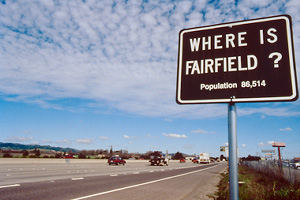
The question "Where Is Fairfield?" was presented as a sing on the highway and near the downtown exit. Artist: Seyed Alavi
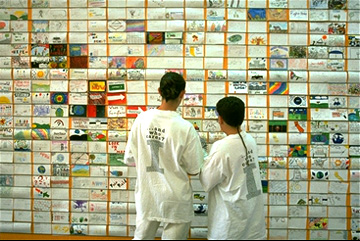
GDS designed T-Shirts. This was the first year of the event. We did more extensive design work in the future years events.
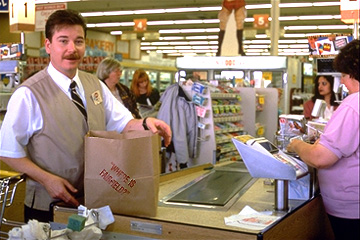
The question was stamped on paper bags of various retail and grocery stores throughout the Fairfield community.
Click on images for larger view
“Where is Fairfield?” was the name of a festival held for several
years by the City.
It was partially inspired by a survey from national site consultant professionals
that found Solano County, including Fairfield, to be virtually unknown
in the community outside the immediate region.
More Info
Finding Fairfield
Public Art Reveals a Community´s Identity
By Philip Pregill
Sometimes simple questions yield complex answers. Fairfield, CA, situated about 40 miles east of San Francisco in rolling orchard country, asked, “Where is Fairfield?” and its citizen responded with diverse answers. The question struck a chord: Fairfield, like many communities across the United States, is in search of itself. As part of the process, the town asked the question through a public art event occured April 7, 1995, and learned much about its image. Many of the projects produced for the event were temporary works, designed to draw the maximum number of citizen into the event. Other works have had long-term results and continue to generate discussions within the community about urban identity and sustainability. Nearly a year after the official event, organizers of “Where is Fairfield?” continue to debate the results of the disparate public art projects and are hopeful that their considerable effort have put down a solid foundation for subsequent public art events.
This project was designed to engage the entire town in the process by asking the populace to respond to the question of Fairfield´s image and how it distinguishes itself from similar middle-size communities across America. The goal was to elicit responses from the community about its past, particularly expressions that revealed the complexity of identity embedded in the community. All segment of the community- business, government, education- were drawn into the process.
Unlike the relatively homogeneous middle-sized communities of a generation or two ago, the Fairfields of the United States are now socially comples towns manifesting economic and ethnic diversity. The project included the town's divers groups in the process and produced a list of 30 smaller projects to engage a broad spectrum of the local population, from established artists to the elderly, from business to the town´s youth.
Just how effective the efforts to engage the community were was evident in the days preceding April 7. At the local high school, students settled on the concept of designing chairs as symbols of places within the community. A community college art class produced street-lamp banners that communicated the location of the town in fact and in memory.Grade schoolers designed postcards that depicted personal impressions of Fairfield, which formed a bold collage along the walls of the Fairfield Art Center.A light project illuminated the “Where is Fairfield?” theme on the city cultural center. The local post office issued a stamp cancellation to commemorate the event. Local businesses got behind the event and sponsored projects: among them were the Budweiser brewery, which produced event T-shirt; several supermarkets that imprinted their grocery bags with the theme; and restaurants that flagged their meals with a notice of the event.The local radio station and the newspaper responded to the challenge by broadcasting and printing “Where is Fairfield?” in their media.
Some less visible projects reached deep into the community, including visits by youngsters to elderly nursing home residents and an oral history project. And the handing out of organes and roses wrapped in paper imprinted with the theme recalled the days when Fairfield as an agricultural community derived its identity more from rural labor that urban commercialism.
With evident creativity and planning the organizers of “Where is Fairfield?” skillfully tapped into the memory and imagination of the community to produce responses that were both immediate and ongoing. Singnificantly, the installations and projects continue to generate public dialogue about Fairfield´s identity. A video project about community identity that engaged gang and non-gang members enlarged the dialogue between the groups. In the case of the oral history project, younger community members probably better appreciate their elders as valuable cultural reources, capable of providing a sense of the past that a community needs to stay vital.
Without a large budget or the pretensions of similar projects in larger cities, “Where is Fairfield?” admirably underscored the potential of public art to transcend artistic preconceptions and to generate broad and original expressions of urban identity from a community that, in its number and habits, resembles so many others in the United States. At a time when art-public, institutional, or commercial-generates questions about relevance, Fairfield, by asking an essential question, not only helped clarify its own identity, but also reaffirmed the ability of public art to stimulate civic enrichment.
Philip Pregill teaches at the College of Environmental Design at California State
Polytechnic University, Pomona.
www.mattpeiken.com/Journalism/
Fairfield/whereisf.htm
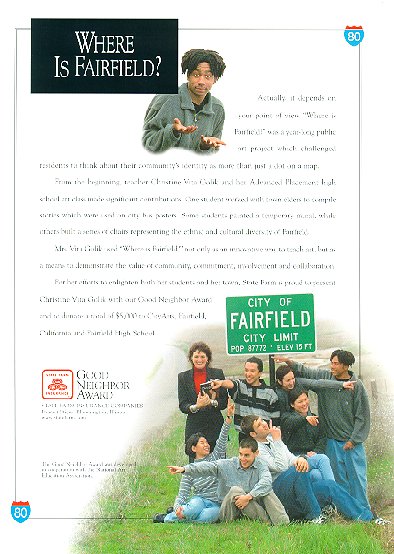
fairfield'sfifteen minutes of fame. my art teacher, mrs.golik, won an
award from state farm insurance. a couple of her students got to be in
a national magazine ad. it was featured in "life", "the
smithsonian" and others.
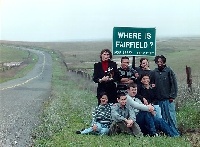
http://www.geocities.com/
CollegePark/8699/where.html
i707
428-1743
imail@garsondesign
iwww.garsondesign
• Advertising
• • Ads
• • Billboards
• • Movie Screens
• Banners
• Billboards
• Bookmarks
• Books
• Brochures-Small
• Business Cards
• Calendars
• Cards
• Catalogs
• Client
Editable
• Copywriting
• Corporate I.D.
• Coupons
• Databases
• Direct Mail
• Display Booths
• Ethnic
• Events
• Flyers
• Forms
• Illustration
• Invitation
• Labels
• Logo
Design
• Maps
• Marketing
• Marketing
Source
• Military
• Newsletters
• Packaging
• Photography
• Photo Retouching
• Political
• Postcards
• Posters
• Presentation
• Folders
• Press Releases
• Printing
• Promotion
• Resume
• Signage
• Slides
• • Movie
Slides
• • Movie
Slide
• • Ordering
• Specialty Items
• Stationary
• Trademarking
• Translations
• T-Shirts
• Websites
• • Websites
• • FAQs
• • GDS
Banner Ads
• Yearbooks
UUpdated: Thu 7/29/10 0:37 AM
UCopyright © 2004 Garson Design Services
U